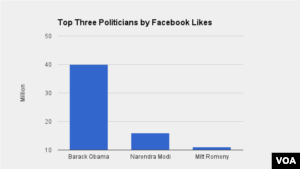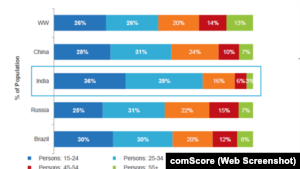The sweeping victory of the Bharatiya Janata Party (BJP) in the recent Indian elections has been attributed to factors ranging from slowing economic growth to high levels of corruption.
 |
| Indian PM Modi |
But for the first time in the country’s history, social media played an important role, according to analysts who are calling the vote India’s first "social media elections."
"The social media effect was huge for the BJP. … They really understood that social media is an extended version of the campaign trail," said Michael Kugelman, a senior program associate for South and Southeast Asia at the Woodrow Wilson Center.
The Facebook candidate
By the time he was sworn in as prime minister, Narendra Modi had more than 16 million "likes" on Facebook, the second most for any politician in the world, and he was the sixth most followed world leader on Twitter.

Taken From Facebook
Modi’s popularity carried the BJP to victory with 282 seats out of the 543 seats in parliament, the biggest win by any party in India in 40 years.
Through its use of social media, the BJP was able to sway many young voters. And while official numbers on the youth vote have yet to be tallied, the BJP clearly won the contest for India’s young voters.
"What we do know from exit polling data is that if you look at demographic support for the BJP in particular, the BJP dominated the Congress when it came to younger voters," said Milan Vaishnav, an associate in the South Asia Program at the Carnegie Endowment for International Peace.
For the BJP, getting young votes meant harnessing the power of social media.
"We saw a trend, we read this trend, where the youth of the country were embracing social media as their first tool when they started using the internet, and we made sure our presence was there," said Arvind Gupta, who as head of BJP’s IT division led the party's social media campaign.
Gupta said BJP's social media campaign was one of the most important factors in its victory. He said social media affected 30 to 40 percent of the overall seats, a number he said could go up to 60 percent by the 2019 general elections.
In many constituencies, social media was amongst the top three communication tools, overtaking traditional methods such as advertisements, he added.
The importance of social media is underscored by the almost 74 million Internet users in the country, a 31 percent increase from March 2012 to March 2013, according to "India Digital Future in Focus." The report was published by comScore Inc., a U.S. company that measures digital usage.
The same report said 75 percent of India’s online population was younger than the age of 35, significantly younger than in other BRIC countries.

"Politicians realized that social media is not a couple of kids talking about fashion, but actually people talking about serious things," said Mandakini Devasher Surie, a senior program officer at the Asia Foundation.
Social media as a campaign tool
"Standard tools like Facebook, YouTube, Twitter and then lately WhatsApp - I think these, from a social media perspective, were the pillars of our strategy," Gupta said.
One of the most interesting uses of social media was when the BJP crowd-sourced its manifesto, with hundreds of thousands of people using Twitter and blogs to comment.
"A lot of those suggestions were actually incorporated in our manifesto," Gupta said.
The BJP used a two-pronged approach to social media: increase its online presence while also helping in its offline activities.
In a program called "organize online to assist offline," the BJP used the reach of social media to recruit volunteers, eventually enlisting 2.2 million, Gupta said.
"Twitter by Modi"
For many Indians, it started with the use of Twitter by Modi, who gained millions of followers during the election campaign, according to Kugelman.
"Mr. Modi himself reached out through his Twitter account to the youth of the country, appealing to what the youth are looking for: jobs, security and the use of technology," said Nilotpal Chakravarti, the associate vice president of the Internet and Mobile Association of India (IAMAI).
The social media campaigns by the BJP, and also by the anti-corruption Aam Admi Party (AAP), which made an impressive showing in the 2013 Delhi assembly elections, helped "define the media narrative."
It created "key messages and talking points" that were then picked up by the mainstream media, said Vaishnav, who is with the Carnegie Endowment for International Peace.
This meant the BJP was able to create a narrative that the Indian National Congress party - which had been in power for the past 10 years but only managed to win 44 seats this election - was “out of sync” with the common Indian, while Modi was more in tune with a population where the median age is 26, according to Vaishnav.
He added that Twitter and Facebook helped break down information barriers between politicians and voters, allowing them to better understand the candidates and the issues they were promoting.
While Gupta, the BJP’s IT leader, believes that social media played an important role in the BJP’s victory, he acknowledged it’s only a part of the overall strategy.
"Where we differed from both the Congress and AAP is that they didn’t have the base content, they didn’t have the base leadership, they didn’t have the base policy and performance record we had," he added.
"You’re not going to win an election only by depending on your social media presence," said Kugelman, from the Woodrow Wilson Center.
He pointed to AAP and the Pakistan Tehreek-i-Insaf in Pakistan, political parties that had a strong social media presence but couldn't convert that into votes because of a lack of national presence.
"The type of messaging and the target messaging, and the agenda on which the election was fought, won them the election rather than social media alone," said Bharath Gopalaswamy, deputy director of the South Asia Center at the Atlantic Council.
Tools to govern
While the election campaign may be over, the BJP’s use of social media will continue, according to Gupta.
"We need to use it more constructively… making sure that what the government is doing is being communicated in a very transparent, real time manner and seeking feedback if something needs to be corrected," said Gupta.
One option put forward is for the different ministries to have their own Facebook and Twitter pages for better two way communication and to act as a tool for engagement, said Chakraveti, who is with IAMAI.
It should be used as a tool for citizen engagement, and the Prime Minister’s Twitter account could be used by Modi to take suggestions from stakeholders and gage their response, he added.
Urban India had 78 million social media users in June 2013. The number rose to 91 million by December 2013, indicating the growing importance of social media, according to the IAMAI report "Social Media in India - 2013."
The potential use of social media to improve transparency could work in the BJP’s favor, said Kugelman, adding that voters in India and other countries complain "that they don’t really know" what a party's or politician's priorities and objectives are.
“So if the BJP could continue to use social media as a major platform for communicating its ideas and goals," Kugelman said, "then I think that’s definitely a good thing.”

No comments:
Post a Comment